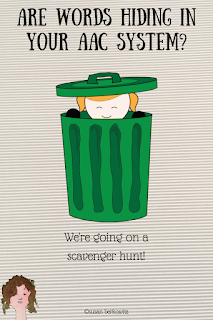If you’re doing therapy this summer, or working with your own AAC user, you might want to spice it up a bit to keep kids engaged with you; instead of what's outside the window!
So, how about a vocabulary scavenger hunt?
Use books or magazines with language-rich pictures. Highlight the vocabulary you are looking for and discuss it. What is it? What about size, color, and shape? What do you do with it? And where is it in your AAC system?
I used to use the Ladybug and Cricket magazines (no affiliate links or remuneration here) because of their great stories, repeating characters, and wonderful illustration. I was pleased to see that they are still around.
Each issue has a theme, and supplies activities and games, as well as the great children’s stories. Read through the issues you are going to use. Choose the target vocabulary and set the purpose for reading: What are they listening for as you read the story to them? Have symbols for words, as they might not be familiar with them (which is the point of this activity, as you recall).
As you read, highlight the target words so that you can come back to them. Use symbol flags (popsicle sticks with symbols stapled to them) for students to raise when they hear the target word.
When you stop to discuss the word, have students tell you about it. If it’s an unfamiliar word, can they use the context or illustrations to tell them about it? Can you discuss the category or function, describe it? And…. Can they find it in their AAC system(s)?
If therapy is the only place your student(s) encounters these magazine stories, then create a story communication board to use during sessions that supplement the student’s own AAC system. That was, while you can focus on core words - like “she” and “he” and “it,” you can also talk about specific characters, whose names can be on a storyboard, but don’t need to be in the dedicated AAC system.
While this activity isn’t meant to be the sole teaching activity for teaching specific vocabulary, it can be a great way to have students practice their vocabulary and practice finding it in their AAC systems.
A spin-off of this activity can focus on reading foundation skills - or phonological awareness. Make flags for specific sounds, and/or number of syllables. As you read, have students hunt for words that begin with a target sound or have (X)# of syllables or rhyme with a key word in the story.
More fun coming next week. In the meantime, keep on talking!




No comments
Post a Comment